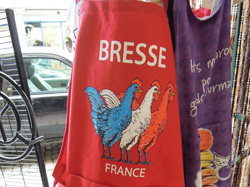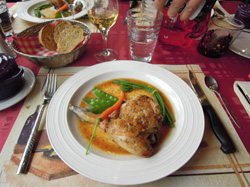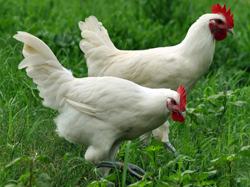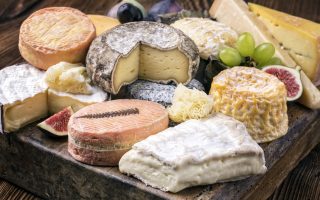Poulet de Bresse, the pick of poultry

The strutting creatures that you occasionally glimpse from the roadside whilst driving through rural corners of Burgundy, Franche-Comté or the northern reaches of the Rhône-Alps, could hardly be better suited to represent both the majesty of the French culinary arts, and an enduring appreciation for all things terroir.
They have all the right colours for a start: with their red crests, clean white feathers and blue, yes blue, feet, they are the animal embodiment of le tricolore (French flag). But don’t be fooled by the look of these pampered poulets. These free-roaming beauties are more famous for their flavour. Ask any chef worth his sel de Guérande, from Heston Blumenthal to chief Bresse chicken flag-waver Georges Blanc, and they will agree – the only clucker that belongs on the top table is an AOC Bresse one.
The origins of a culinary icon
 In rural France dating back as far as the 17th century, it was always the farmer’s wife that looked after the chickens, as well as making cream and butter to sell at market. They would take their fine looking chickens along to sell and a spirit of competition soon evolved among the sellers. Actually, such was the value of these feathered friends that some farmers even paid their rent in chickens.
In rural France dating back as far as the 17th century, it was always the farmer’s wife that looked after the chickens, as well as making cream and butter to sell at market. They would take their fine looking chickens along to sell and a spirit of competition soon evolved among the sellers. Actually, such was the value of these feathered friends that some farmers even paid their rent in chickens.
By the 19th century, when gastro legend Brillat-Savarin declared the poulet de Bresse to be ‘the queen of poultry and the poultry of kings’, proper competitions had begun in Paris (1865) but it wasn’t until 1957 that the product attained its illustrious AOC (Appellation d’Origine Contrôlée) status. It remains the only poultry in France with such a label and today its worth is judged at the annual Glorieuses de Bresse competitions, just in time for Christmas and the New Year.
Reign of terroir
 Breeding takes places in the Bresse region across three departments – Ain, Saône-et-Loire and the Jura, all of which have bocage (a mixture of woodland and pastureland) on which the animals can roam. Each chicken must be guaranteed at least 10sqm (some get more), and the breeder must give them maize and wheat, plus milk from their 35th day. It must also be allowed to graze on grass, worms, seeds and insects to complement its diet.
Breeding takes places in the Bresse region across three departments – Ain, Saône-et-Loire and the Jura, all of which have bocage (a mixture of woodland and pastureland) on which the animals can roam. Each chicken must be guaranteed at least 10sqm (some get more), and the breeder must give them maize and wheat, plus milk from their 35th day. It must also be allowed to graze on grass, worms, seeds and insects to complement its diet.
There are around 180 breeders working today with a production of about one million chicks and in order to maintain standards, all chickens must pass throught the selection centre at St-Etienne-du-Bois in Ain to verify all the characteristics are in place: a uniform fineness of the skeleton, hardiness, blue feet and white feathers.
After that, the poulterers (about six in the region) do their work, taking care not to damage the chicken’s fragile skin, and the meat is ready for the butcher’s shop or the restaurant kitchen. Simple roasting, taking care to baste the skin regularly, or cooking in a cream sauce, are the preferred methods of cooking this sought-after icon of French cuisine.
Share to: Facebook Twitter LinkedIn Email
More in burgundy, centre, cooking, food, paris, restaurants, work
Leave a reply
Your email address will not be published. Required fields are marked *



